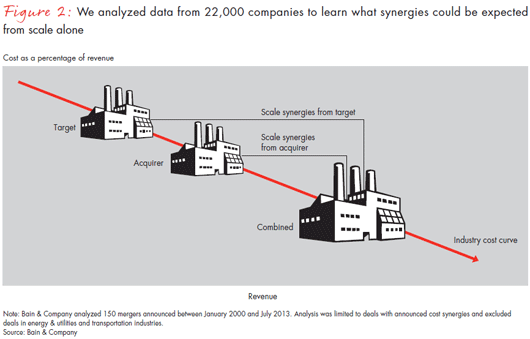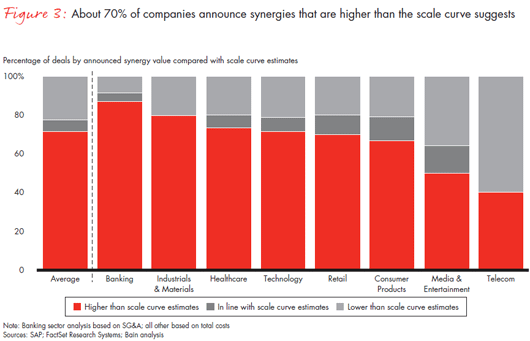Brief
The open secret about M&A is that most deals fail to generate the synergies companies expect when they announce a merger. In a Bain & Company survey of 352 global executives, overestimating synergies was the second most common reason for disappointing deal outcomes (see Figure 1).
One of the causes of this overestimation is well known: Companies set aggressive targets to justify a deal price to financers. But new Bain analysis comparing deal announcements with the performance of more than 22,000 companies across a range of industries has unveiled another, even more fundamental contributor to the rampant overestimation. Most merging companies entering a deal don’t have a clear understanding of the level of synergies they can expect through increased scale. They typically make broad estimates based on prior deal announcements, without considering whether the cost structure of the combined entity is realistic based on benchmarks of like-sized companies. For example, if two $100 million companies merge, they rarely know what the resulting cost structure will look like based on their industry’s existing $200 million companies.
We took a hard look at synergies in M&A to understand what the best companies do when estimating, announcing and pursuing them. We wanted to see whether merging companies’ announcements matched the synergies that should be expected given their industry, size and initial cost position. Are scale benefits alone justifying announced synergies? Are companies using due diligence and integration planning to improve underlying performance and reduce overlapping costs?
To answer these questions, we embarked on an extensive M&A research effort. Bain recently analyzed data collected from SAP and FactSet Research Systems on the performance of more than 22,000 companies across a range of industries and geographies and spanning from the smallest public companies to those as large as $100 billion in revenues. We created cost curves for each industry, which showed the margins achieved for companies based on their size and industry. As expected, larger companies typically have lower costs as a percentage of revenues, and the benefits of scale differ significantly by industry. For example, telecom companies, with their fixed-cost infrastructure, show the most benefit, while retailers, with their distributed costs, show the least.

By comparing the predicted margins for two standalone businesses with the margins for a single entity of their combined size, we estimated the scale synergies they could achieve by merging (see Figure 2). We then looked at mergers and compared announced synergies with what would be expected based on our cost curves. We found that across most industries we analyzed, on average 70% of companies announced higher synergy estimates than would be expected just by companies getting bigger (see Figure 3). We also wanted to examine the incremental benefits of M&A on companies whose cost structures had lagged industry norms before the merger. Like most merging companies, these companies announced higher synergies than would have been expected from scale benefits alone—but we learned that even their overestimated synergies wouldn’t have been enough to close the cost gap to competitors. In other words, they aimed high, but not high enough to put them on even footing.


These findings helped us determine how companies can be more grounded in their estimates and learn from those that have been most successful in using M&A to win cost advantages. If most companies don’t achieve their announced synergies—and given the cost curves in their industries, those synergies announcements are too bold—how do the best companies beat the odds?
Learning from outperformers
The best companies justify higher targets and provide a roadmap for achieving them. They use the disruption caused by M&A to pursue broader changes like adopting zero-based budgeting initiatives and incorporate new ways of working that help them surpass rivals to become cost leaders. These companies gain at least—if not more than—the synergies they promised at the deal’s outset. In addition to reaping the benefits of scale, they also reach full potential for the combined companies by focusing on removing inefficiencies in their merged organizations and creating breakthrough performance.
That approach requires merging companies to be far more disciplined about calculating expected synergies. It also requires them to use industry benchmark data to get a firm grasp on how each company’s costs stack up prior to the transaction and to understand how much can be gained from scale alone, as well as from the additional effects of achieving higher levels of cost performance. When setting their desired end point, the best companies also explicitly set a target for how their costs will ultimately compare with those of larger, best-in-class rivals, recognizing that the competition will continue to improve over time.
Few companies illustrate this approach better than AB InBev, the world’s largest brewer created from the 2008 merger of Anheuser-Busch and InBev.
Like many other companies, AB InBev announced anticipated synergies in its huge merger that were higher than what could be expected from scale alone. But unlike so many others, they entered the merger with both a track record for high synergies and a solid plan to back up their claim. They ultimately beat the ambitious announcement by generating synergies of $2.25 billion, much more than what could have been expected from scale. On average, merging consumer products companies increase EBITDA by 3.2% of target net sales. In the case of the AB InBev merger, those synergy gains contributed to a 16.8% improvement over a three-year period following the transaction.
A diversified industrials company formed by the merger of two giants also serves as an example of synergy excellence. The merged company took advantage of the acquisition process to get everybody on board for transformation. Based on industry benchmarks, the merged company would have expected to achieve scale synergies representing just 1% to 2% of the combined companies’ revenues. It did far better. All told, the acquisition delivered synergies amounting to more than 5% of revenues.
Most merging companies don’t have a clear understanding of the synergies they can create by increasing scale. However, some companies set bold targets and consistently hit them. Laura Miles, who leads Bain's global Mergers & Acquisitions practice, explains what sets these companies apart in this short video
Synergy overachievers typically follow three critical rules for repeating success:
Begin by using the deal thesis and rigorous due diligence to pinpoint where scale synergies and best practice benefits will have the most substantial effect. Winners always know exactly what they hope to gain in a merger.
A deal thesis spells out the reasons for a deal—generally no more than five or six key arguments for why a transaction makes compelling business sense. According to Bain’s survey of nearly 250 global executives, in 90% of successful deals, an acquirer’s management team had developed a clear investment thesis early on.
Knowing what you hope to achieve is the first step in clearly identifying where the deal can create value and which few things are critical to delivering that value. The deal thesis leads directly to the structure of the integration. It determines how quickly you need to move on each initiative to tackle the largest opportunities first and with the most resources. By conducting a deep business analysis of all target companies, the industrials company pinpoints where overlap of costs and customers will generate the greatest scale benefits, beyond traditional general and administrative functions.
In areas that will deliver the most value, use benchmarks and the industry-specific scale curve to know your starting and desired end points compared with those of your competitors. In our experience, too few companies enter a deal really knowing how they measure up against competitors. Again, benchmarks and the industry-specific scale curve allow you to see where you stand and how much you need to deliver to be competitive with the median or the leaders. Such resources as SAP’s Value Management Center, which includes a database of more than 4,000 companies, arm acquirers with information to make more realistic predictions of synergies and also show them where to find those synergies.
When the two industrials companies mentioned above merged, they relied on a deal thesis and function-by-function benchmarks to know where to expect the greatest synergies. They also examined costs down to the subfunction level—in areas like tax and treasury, for example—to identify potential synergies. And they considered benchmarks from multiple angles: Instead of just looking at the cost of a specific function like field human resources, they also considered such benchmarks as HR employees-per-field headcount—anything that could be contributing to the gap against the best performers. That allowed the combined companies not only to set aggressive goals but also to see where each had strengths that could be adapted to help the combined entity perform above industry benchmarks.
Be deliberate if you choose to use M&A to gain cost benefits beyond scale improvements, and be realistic about your internal capabilities. The disruptive nature of M&A and the integration process opens up the opportunity to implement a broad performance improvement agenda across the organization. Winning companies distinguish between areas they are primarily integrating and those they are optimizing beyond pure scale benefits. They thoughtfully choose where to do one, the other or both, and they are generally selective about where they try to optimize.
The merged industrials company approaches the goals of integrating and optimizing with different organizational oversight, tools and goal setting. For integration, the focus is on making sure the businesses come together seamlessly and don’t miss a beat in performance—teams’ missions and metrics are tailored to that objective. When the goal is optimizing, teams are given more aggressive cost targets and benchmarks for where the potential savings are likely to reside. They’re provided with financial support and resources to help identify opportunities and to execute, with performance clearly measured against their targets.
In its acquisitions, AB InBev simultaneously establishes integration, oversight and change management programs from the outset. It then sets targets and ensures the right tools and processes are put in place to manage costs across the organization. For example, the company sets standards and benchmarks for best practice brewing operations. It also standardizes sales and delivery routines to increase efficiency, relying on the best approaches, either from AB InBev or the acquired company.
The ultimate result: When it acquired the stake in Grupo Modelo it did not yet own last year, a considerable part of the earnings value came from new performance improvement initiatives, not from typical synergies.
As M&A reshapes the competitive landscape in many industries, these three critical steps—deal thesis, benchmarking and performance improvement—are what make some acquirers synergy overachievers, while others wonder why they consistently miss the mark.
Laura Miles is a Bain & Company partner based in Atlanta and leads the firm’s global M&A practice. Adam Borchert is a partner based in Boston, and Alexandra Egan Ramanathan is a partner based in Chicago.
The authors wish to thank SAP’s Value Management Center for use of its benchmarking database of more than 4,000 companies. Together, Bain and SAP use the power of this database to assist clients with gauging the performance improvement potential of their businesses.